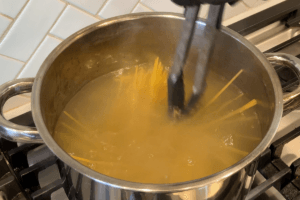Pasta Carbonara – A Must-try!

Pasta Carbonara is a classic Italian dish made with just a few simple ingredients. These ingredients blend to create a creamy, delicious sauce—no cream needed. The rich flavor comes from crispy pancetta (or guanciale for a traditional touch). This adds a savory kick to the sauce that makes Carbonara so beloved. Great for busy weeknights or a relaxed weekend meal, this recipe highlights the straightforward and tasty style of Italian cooking.
The Origins of Pasta Carbonara
The origins of the iconic Italian dish, Pasta Carbonara, remain a bit of a mystery. One popular story is that American troops stationed in Italy after WWII brought powdered eggs and bacon. Italian cooks adapted these ingredients, using fresh eggs and pancetta instead. This adaptation quickly became a Roman favorite. Another theory suggests that Italian coal workers, known as carbonari, inspired the dish. After a day’s work, they enjoyed it as a hearty, simple meal, and the black pepper is said to resemble specks of coal dust, adding to the “coal miner” connection. Despite its mysterious beginnings, Carbonara became a staple of Roman cuisine and eventually gained worldwide popularity. With just eggs, cheese, pork, and pepper, it beautifully showcases the simplicity of Italian cooking.
Perfect Side Dishes to Pair with Pasta Carbonara
These sides not only round out the meal but also add layers of flavor and texture, enhancing the overall dining experience.
- Green Salad with Vinaigrette: A crisp green salad with a tangy vinaigrette brings a refreshing contrast to the rich pasta. The tart dressing cuts through the creamy sauce, balancing out each bite.
- Roasted or Steamed Veggies: Add color and crunch with lightly roasted or steamed asparagus, broccoli, or green beans. These vegetables pair well with the pasta and add a touch of freshness.
- Garlic Bread or Crusty Italian Bread: For soaking up every bit of the rich Carbonara sauce, garlic bread or a slice of crusty Italian bread is ideal, adding a little crunch to the meal.
- Caprese Salad: Fresh tomatoes, mozzarella, and basil in a classic Caprese salad add a bright, fresh flavor that complements the creamy pasta and enhances its Italian character.
- Grilled Chicken: A light addition of grilled chicken provides protein and a bit of heartiness without overpowering the dish, keeping the meal balanced.
Conclusion
Pairing Pasta Carbonara with the right sides elevates the dish into a truly satisfying meal. From a refreshing green salad to classic Italian garlic bread, each accompaniment brings something unique to the table, balancing the creamy, savory pasta with fresh flavors and textures. Whether you’re enjoying Carbonara as a cozy dinner or serving it for guests, these simple yet thoughtful sides add depth and complete the experience. With a perfect blend of flavors, your meal will feel both balanced and memorable—just as Italian cooking intends.
Pasta Carbonara
Equipment
- 1 large sauté pan
Ingredients
- 12 oz spaghetti
- 4 oz pancetta sliced into small strips (or guanciale if available)
- 4 large eggs
- Salt and black pepper to taste
- 4 oz Pecorino Romano cheese grated
- 4 oz Parmigiano Reggiano cheese grated
Instructions
- Gather the Ingredients: Start by preparing all ingredients.
- Grate the Cheese: Freshly grate the Pecorino Romano and Parmigiano Reggiano cheeses. Freshly grated cheese brings a vibrant flavor to the dish.
- Make the Cheese and Egg Mixture: In a bowl, whisk the eggs with the Pecorino Romano and Parmigiano Reggiano. Add plenty of black pepper for classic Carbonara flavor.
- Cook the Pasta: Bring a pot of water to a boil, add the spaghetti, and sprinkle in a little salt. Cook until just shy of al dente.
- Cook the Pancetta: While the pasta cooks, heat a skillet over medium heat. Add the pancetta strips and cook until crispy. Once done, turn off the heat, and reserve a teaspoon of rendered fat from the pancetta for later use.
- Combine Pasta and Pancetta: Once the pasta is ready, transfer it to the pan with the pancetta, tossing to coat the spaghetti in the pancetta fat. Add a small splash of reserved pasta water if needed to help coat the pasta.
- Finish the Sauce: With the heat off, pour in the egg and cheese mixture, tossing the pasta vigorously to create a creamy sauce without scrambling the eggs. Tossing in the residual heat of the pan will emulsify the sauce, making it smooth and velvety.
- Serve: Drizzle the reserved pancetta fat over the pasta for an extra layer of flavor. Top with additional cheese if desired, and enjoy the rich, cheesy, and peppery flavors of this Pasta Carbonara.
Video
Notes
- Make Sure the Heat is Off: When adding the egg mixture, turn off the heat. The residual warmth of the pan will cook the eggs just enough to coat the pasta without scrambling, giving you that smooth, creamy sauce Carbonara is known for.
- Use Room-Temperature Eggs: For the smoothest sauce, take the eggs out of the fridge beforehand. Room-temperature eggs blend more easily with the cheese and pasta, helping to create that silky texture.
- Stir Quickly and Constantly: Once you add the egg and cheese mixture to the pasta, stir quickly and continuously. This keeps the sauce from clumping and helps it blend evenly with the pasta.
- Don’t Overcrowd the Pan: Use a large enough skillet or pan so the pasta has room to spread out when you’re mixing. This lets each strand get coated evenly and helps with heat distribution.
- Add Pasta Water Little by Little: Use just a splash of pasta water at first. You can add more as needed to reach your desired consistency, but adding too much at once can thin the sauce too much.
- Serve Right Away: Carbonara is best enjoyed immediately, as the sauce can thicken as it cools. For the creamiest experience, dig in as soon as it’s done!










I like it!